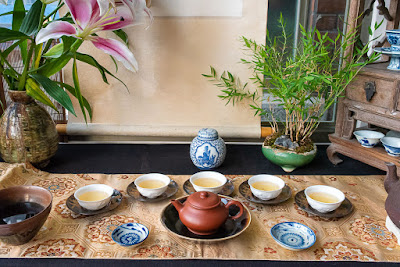With so many teas to taste, he conducted his tasting in 2 rounds. First, 10 batches from plantations with high yield/high production. Then 7 small batches. You can see those below. The small batches are in front and the large ones behind.
The way this tasting is done is similar to what happens in a tea competition. The same amount of leaves is weighed for each cup (3 grams). Then they are all brewed for 6 minutes with boiling water and emptied in the large white cup. Since the tea is too hot right after it's poured, the farmer starts by simply smelling the leaves. After a couple of minutes, when the tea isn't too hot anymore, he uses a tea spoon to pour some tea in his own cup and quickly tastes one tea after another.
What comes next is quite interesting. Look at the table and notice the red line. After tasting each tea, the farmer changes the place of the brewing cup according to the quality of the tea. A cup close to the edge of the table means a low grade. A cup that reaches or exceeds the red line means that it's outstanding.
This visual grading of quality serves 2 purposes. First, it helps the farmer to price his teas fairly (top quality is priced higher than average quality tea). Second, it can also help him to blend batches of similar quality, so that he doesn't have 17 different teas, but just 4 or 5 levels.
Of course, if he gave me the privilege to taste all his winter Oriental Beauties, the farmer also hopes that I will purchase some. Especially since he knows that I prefer to purchase single batches instead of blended teas. For me, this was learning experience that you don't get every day. And, despite the tough brewing standards aimed at highlighting the teas' defects, I was blown away with the outstanding quality of some of his teas. These exceptional teas will cost a fortune in Taiwan tea houses and usually you don't get to try them! (For reference, the price for the winner of the Oriental Beauty Oolong competition in HsinChu has reached a new record of 1 million NTD, 35K USD, for 600 gr 2 years ago).
But let's go back to the teas. What struck me was how impossible it was to tell the quality from the appearance of the leaves. Even the size and the amount of buds wasn't such a good quality factor. And actually it makes sense. The number 1 driver of quality for Oriental Beauty is the concentration of these particular flavors that only develop with lots of jassid bites (xiao lu ye tsong). You can't see these bites on dry leaves! And you can barely smell them when the leaves have been recently roasted.
But boy, oh boy, it makes such a difference when the leaves have this scent compared when they barely have it! The tea is at another level, in another dimension. So, as you can see, I did purchase one of the small batches from that second group of OBs. This batch weighs only 3 kg. It was harvested on October 27th 2020 and I've called it the ultimate Oriental Beauty! Its concentration is even stronger than the 'perfect OB' I found in 2007!
Such a rare tea isn't for everyday. It's not meant to be brewed in a haste while doing something else. But it's one these dream teas that all tea lovers wishes to have had at least once in his life to know just how magical tea can be! I think it's the perfect tea for a wedding anniversary or to celebrate a feminine birthday.
It's a perfume of honey that tastes like liquid gold!
A beauty!











No comments:
Post a Comment